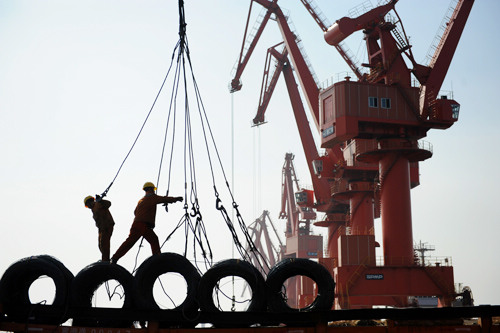|
 |
|
OPENING UP: Workers load cargo at the Yingkou Port, Liaoning Province, one of the country's 10 largest ports after 30 years of development (LI JUNDONG) |
According to China's provincial economic data for 2011, central and western regions outpaced the east coast in GDP growth last year. Ever since the reform and opening-up drive was initiated in the late 1970s, the east coast regions have enjoyed torrid growth momentum thanks to favorable government policies and geographic advantages. In striking contrast, the central and western regions lagged behind, and the regional gap widened gradually. In response, the Chinese Government has spared no effort to bridge the divide. It seems that those government measures are already taking effect.
East coast provinces still dominated top spots on the ranking of provincial GDP, but their growth rate has been dipping below that of western regions. In 2011, the biggest provincial economy was south Guangdong Province with a GDP of 5.3 trillion yuan ($837.3 billion). Sichuan Province topped western regions with a GDP of 2.1 trillion yuan ($331.8 billion). Economic growth rates of Guangdong, Jiangsu and Zhejiang provinces stood at 10 percent, 11 percent and 9 percent, respectively. The growth rates of most western provinces exceeded 10 percent. Chongqing Municipality, in particular, grew a robust 16.4 percent last year, making it the fastest growing provincial economy in the country.
Fan Hengshan, Director of the Department of Regional Economics under the National Development and Reform Commission, said China kick-started a series of national programs in the late 1990s to stimulate the development of central and western regions, as well as the old industrial bases in the northeast. "Especially in the past few years, the government has handed out generous policy incentives and mapped out a string of regional development blueprints, which brought remarkable benefits to the less wealthy regions," he said.
"China is making obvious improvements in balanced regional economic development," said Fan. "In the past, the eastern regions took the lead in growth momentum, leaving central and western regions far behind. But since 2007, the western regions have outgrown the eastern areas, and the trend has become even more pronounced."
"This is a vital change," he added. "Accelerating economic growth is only the first step for the central and western regions before they can make substantial improvements in fiscal strength, per-capita income and public services."
Fan pointed out that vibrant growth of western regions has provided the country with many new growth points. "The traditional pillar areas, such as the Yangtze River Delta, the Pearl River Delta and the Bohai Rim, have regained steam. Most importantly, emerging economic regions are strengthening, including the Chengdu-Chongqing Economic Zone, the Beibu Bay Economic Zone in the Guangxi Zhuang Autonomous Region and the Wanjiang River Urban Belt in Anhui Province."
"Those new growth engines have injected fresh life into the economy and helped the country better overcome the negative impact of the global financial crisis," said Fan.
"Nevertheless, the central and western regions still have a long way to go before surpassing eastern regions in overall economic scale," said Fan. "Moreover, the central and western economies are largely driven by buoyant investment, and consumption has yet to play a bigger role."
In 2011, fixed asset investments of eastern regions totaled 14.45 trillion yuan ($2.3 trillion), an increase of 21.3 percent year on year, 1.5 percentage points lower than last year. The growth rates of Beijing and Guangdong, in particular, decreased 8.6 and 6.8 percentage points, respectively.
Meanwhile, consumption became a strong force in shoring up eastern economies. Retail sales of all the 11 eastern provincial economies witnessed year-on-year increases. Obviously, the efforts of eastern regions to rebalance their economies are bearing fruit.
Last year, the GDP of most Chinese provinces reached the level of middle-income countries. The per-capita GDP of Shanghai, Beijing and Hangzhou exceeded 80,000 yuan ($12,638), which was close to the level of wealthy nations according to standards set by the World Bank in 2010.
|
